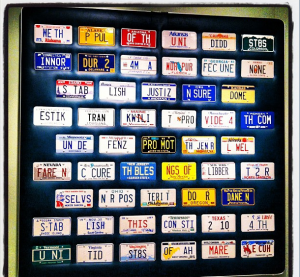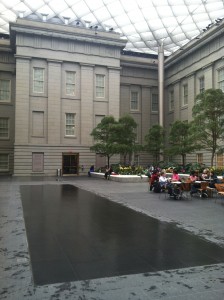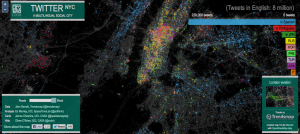As a Kindle user, and more importantly, as someone who plans to work in digital publishing, I found this exercise very informative. I initially attempted to find my favorite book, A Prayer for Owen Meany by John Irving, but it was only available on Google Books. So, onto a favorite I knew would be a more viable option: Jane Austen’s Pride and Prejudice.
I am fairly familiar with free domain books, as I have downloaded many from Amazon.com for classes. In fact, I have Pride and Prejudice via free download on my Kindle. I was not, however, familiar with the answers to any of the questions Professor Kirschenbaum asked us to investigate.
Pride and Prejudice was available on all four platforms: Project Gutenberg, the Internet Archive, the HATHITrust, and Google Books. With so many options to choose from, I dove into Google Books to see what I could find about the provenance of the book. Where to begin? There are seven versions available on page 1 of the initial search alone! A sampling includes editions from Harvard dating from 1962 but copyrighted in 1918, Lenox Library with an 1853 copyright, and even a version from an imprint located in our neighbor Rockville, MD from 2008. Some copies can only be read on the Google Books website, but others have a PDF and EPUB versions available. From experience, I know PDFs can easily be transferred to an e-reader. Thus, with the PDF, the reader now has four options on how to read—on the computer, printed out, on a smart phone, or on an e-reader.
The graphics and formatting were retained in all of the versions I researched. Additionally, all of the versions I opened had a search feature. Only a few had the option for reading the text in a more user-friendly way. Some had options of reading one page at a time, side-by-side as you would a hard copy, and via thumbnails. You can even save the book to your own online library. As far as highlighting, Google Books had at least one version where you could create clippings and share them via social media. For additional social media options, you can write your own review. I did not, however, find a place where you can write about errors, nor did it seem there were any restrictions to usage, despite a Terms of Service. Overall, Google Books was very user-friendly and provided a variety of ways to personalize your reading experience.
Next it was onto Project Gutenberg. I was overwhelmed from the get-go when my search returned 29,141 downloads. Further investigation led me to realize this was how many times the book had been downloaded for free. From here I was given a variety of ways I could view and download, from HTML to QiOO Mobile, something I’ve never even heard of before. I clicked on the very first HTML link. There, I was greeted wit an interesting message:
This eBook is for the use of anyone anywhere at no cost and with
almost no restrictions whatsoever. You may copy it, give it away or
re-use it under the terms of the Project Gutenberg License included
with this eBook or online at www.gutenberg.org
This intrigued me because, in my former life as a TV producer, there were restrictions on everything from music videos, to still images, to movie clips. Everything came with a price and specifications as to how it could be used. But what really got me was the release date of August 26, 2008 and a note that the version had last been modified November 5, 2012. Surely Pride and Prejudice has not changed in the 200 years since it was first published. But then, at the very bottom of the site, the full terms of license are listed. Again, there were two interesting passages:
Updated editions will replace the previous one--the old editions will be renamed.
How are these editions being updated? Why do they need to be updated? What is being modified? My questions were endless. Then:
You may use this eBook for nearly any purpose such as creation of derivative works,
reports, performances and research. They may be modified and printed and given
away--you may do practically ANYTHING with public domain eBooks.
This clause shocked me! If you can do anything with public domain books, can we trust that we are getting the book as it was intended? Are we getting the whole book, or some annotated version? Because it can be modified in any given way, it seems as if we are given license to recreate the book to our liking. Forget Elizabeth ending up with Darcy, let’s just change it around to have her wind up with the abhorrent Wickham.
The one option I found especially interesting on Project Gutenberg was the availability of a QR code, so that the user can scan it with their smart phone and automatically download a version to their mobile device. PG also offers a link to “mirror sites,” which are mostly international universities offering the same version of Pride and Prejudice for download from their university library. I found this to be disappointing because I was hoping it would offer me a version of the book translated into other languages, but it did not. While it first appeared that PG was going to offer many versions of the book, all formats led to the exact same version, which is much different than the variety offered on Google Books, but also gave me a sense of faith that perhaps Pride and Prejudice wasn’t being mangled by users doing anything they want with the text.
Using the Internet Archive initially appeared to just cull the books that had been digitized elsewhere. In fact, various versions specified they came from Google Books—the same Harvard version mentioned earlier—and Project Gutenberg. Despite the versions being the same, the Internet Archive had a much more user-friendly format. If you desired to read the book online, it immediately led you to a side-by-side page layout, that, when flipping pages, animated the page turning. It also allowed the graphics to be seen more clearly. One of the most unique features was that the version was available as an audio book. However, the audio was very computerized and it attempted to read aloud quotation marks and other punctuation. While none of these features change the text, somehow it made it a little more enjoyable to know of the bells and whistles available.
The Internet Archive also offered your basic search functions, download options, and a place to write user reviews. Strangely, the terms of use has not been modified since 2001. Surprising given how much has changed in the digital humanities in the past 12 years. It did, however, give an email address to contact someone about copyright information. One of the versions even had a link to an editable page, where you can edit the book. Thus far, only eight users had done so since 2008. I guess people aren’t as inclined to mess with classics, until you have the bright idea to write Pride and Prejudice and Zombies, as Seth Grahame-Smith did.
Finally, it was onto HATHITrust. As soon as I clicked on the page I knew it wasn’t nearly as user-friendly and complete as any other online library. The initial results only returned options that would search for the book in hard copy at nearby libraries. It was the eighth result that was actually a full-view online version. I clicked, only to find it was the trusty ol’ Google Books version yet again. It too had the side-by-side page flip option, but the words were so small you couldn’t read them and the zoom feature did not work. The only was to read it online was in the traditional view. However, it was available for PDF download just like the others.
HATHITrust also had what I’ve now come to realize are the basic features of an online library: document search, a personal online library, and a way to share links from the book on a social networking site. It did have a more prominent feedback link for users to share how they found the quality of the text. One reportable problem is missing parts—perhaps they got an editable version.
Overall, Google Books and the Internet Archive had the best sites, in my opinion. Either way, I think it’s great there are so many classic books available to readers so easily. No matter which site was chosen, the reader was going to get a legitimate copy of Pride and Prejudice, one of the most beloved books of all time. As for me, I’ll stick to my Kindle for reading digital books for now. However, a hard copy version will always be my first love.















